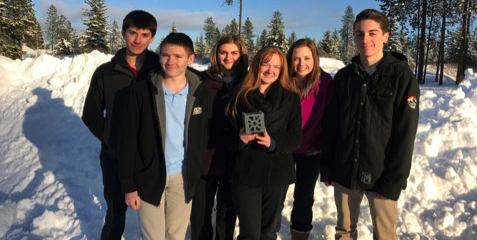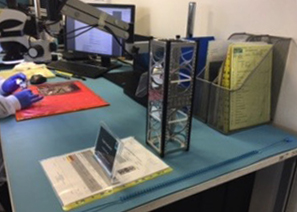RATHDRUM — Many of the lights in the night sky are not stars, but actually man-made satellites, and those satellites could soon be joined by one built by North Idaho STEM Charter Academy students.
With the backing of NASA, six students will launch a four-inch, cube-shaped satellite called a ‘CubeSat’ into Earth’s orbit in June. The CubeSat, named Project DaVinci, is the only high school project to be selected for the launch of the ELaNa 14 (Educational Launch of Nanosatellites) program.
Caldwell High School students also worked on a CubeSat project, but as part of the Northwest Nazarene University college team.

“We are determined to reignite the magic of the Apollo days,” said Joe Broder, a junior at North Idaho STEM Charter Academy. “Being part of this is very exciting, but also intimidating.”
The CubeSat will launch from New Zealand into space while on board an Electron rocket. Once in orbit, students will be able to go online and control the camera on board to look into the universe.
Project DaVinci was selected by NASA for its education focus. The team hopes to get schools from around the world to participate in their satellite program through sending Morse code messages to students. Schools will be able to interact with the CubeSat through the team’s website and participate in lesson plans focused on science, technology, engineering and mathematics.
“Our goal of the mission is to give the average person access to space, so they can learn and feel apart of it,” said Jessica Millard, a junior at North Idaho STEM Charter Academy.
The satellite will also hold a digital living time capsule with music, movies, video games and digital books. Singer-songwriter Taylor Swift is joining forces with Project DaVinci and will handpick music and a personal message that will be downloaded onto the capsule along with work from Joss Whedon, the writer and director of “The Avengers”.
Students were inspired by Carl Sagan’s phonograph time capsule that went to space on the Voyager Mission in 1977. NASA has approved the teens’ satellite launch for June 23, 2017, 40 years after the original launch of the Golden Record.
“I believe these teens are setting an example for other students around the world,” said Beth Brubaker, the education specialist for Project DaVinci and educator at North Idaho STEM Charter Academy.”This shows people what high school students can do.”
Students began designing Project DaVinci in October 2015 with three teachers and 12 mentors. Some of their mentors include Julian Guthrie, a journalist and author of the book “How to Make a Spaceship,” and Burt Rutan, an aerospace engineer who built SpaceShipOne — the first private spaceship to go into space.
“Having mentors made us realize that you don’t have to be NASA or a space company to launch something into space,” Millard said.
With not having the facilities, the time, or knowledge to build the CubeSat, students outsourced the construction to a company in Scotland called Clyde Space. The students along with their mentors still designed the entire satellite. Students continue to log eight hours a week on the design process.

“Clyde Space is a large company with dozens of employees who have a successful track record of building satellites. We’re extremely confident that things will work,” Millard said.
After testing in February, the satellite will head to Cal Poly State University, San Luis Obispo, for NASA to integrate into the launch. Students hope to travel to New Zealand and watch their CubeSat go into orbit.
The satellite cost $250,000 to design, build and transport to the launch site. Students have raised more than $25,000 through business donors and a kickstarter.com campaign.
“NASA has helped us by covering the cost of the launch for our satellite, but that is the extent of their financial support,” Millard said. “If we do not meet our funding goal we have pledges from a few community members who will fund our project if necessary, but our goal now is to raise the money on our own.”
Northwest Nazarene University is among the 20 selected to participate in the ELaNa 14 program.
